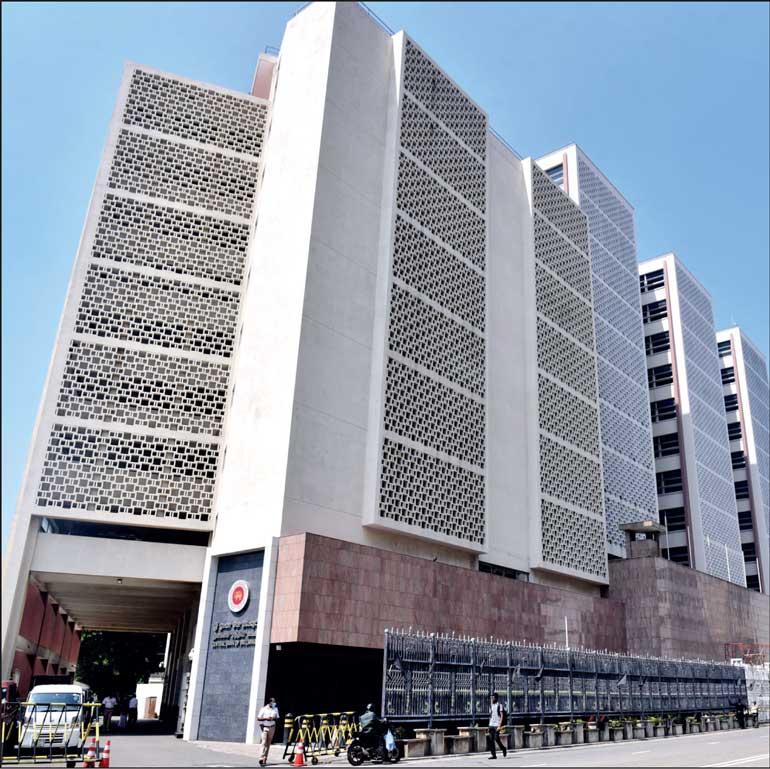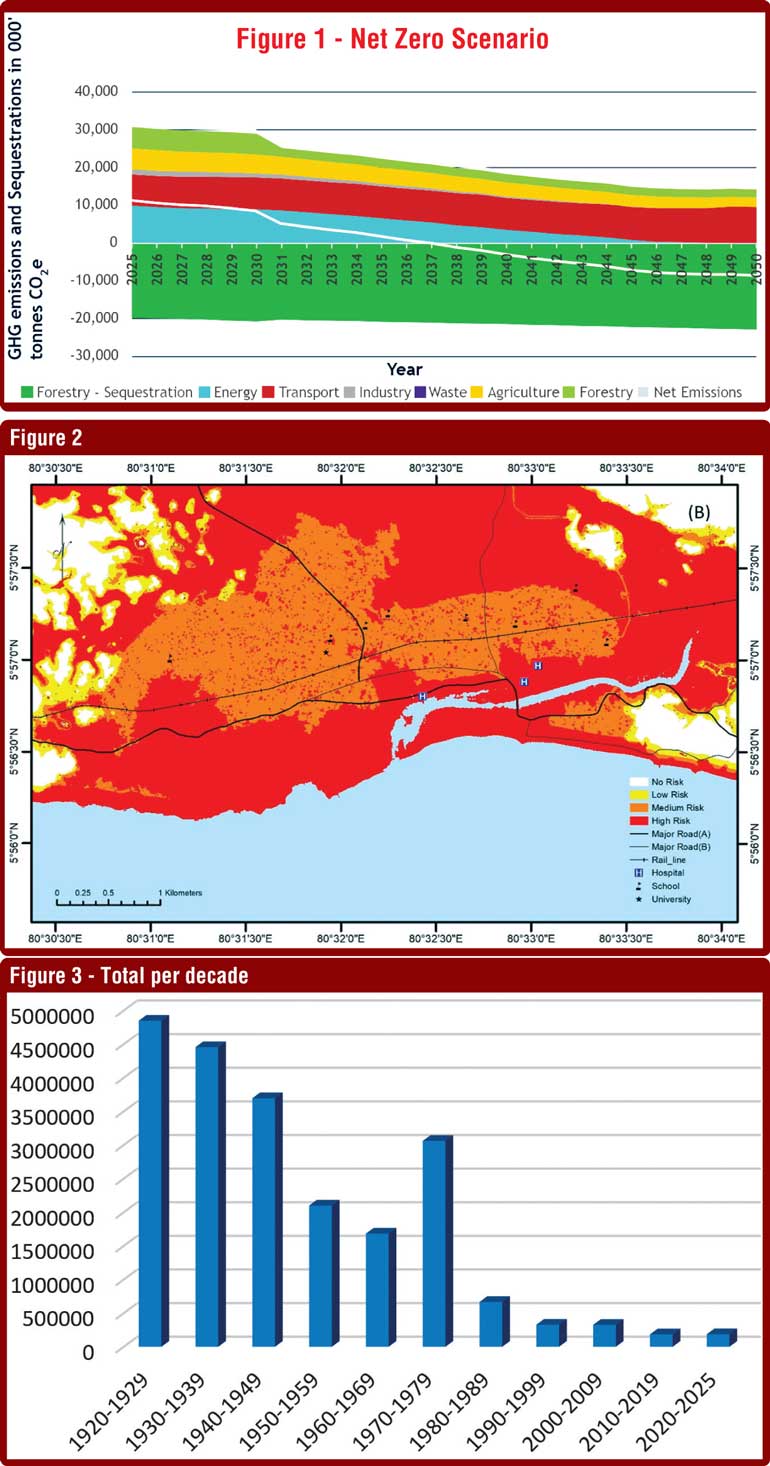Sunday Dec 14, 2025
Sunday Dec 14, 2025
Friday, 30 May 2025 03:15 - - {{hitsCtrl.values.hits}}

Now, by uncritically cherry-picking illusionary prescriptions as a response to climate change, the Bank risks imperilling Sri Lanka all over again

 Sri Lanka’s rise from the ashes following the economic collapse of 2022 owes largely to the competence of the Central Bank, especially its Governor, Dr. Nandalal Weerasinghe. It is easy to forget, however, that the country’s economic collapse too, was precipitated largely by the Central Bank.
Sri Lanka’s rise from the ashes following the economic collapse of 2022 owes largely to the competence of the Central Bank, especially its Governor, Dr. Nandalal Weerasinghe. It is easy to forget, however, that the country’s economic collapse too, was precipitated largely by the Central Bank.
This owed in large measure to the questionable competence of Dr. Weerasinghe’s predecessors, the ‘Modern Monetary Theorists’ Professor W.D. Lakshman and Ajith Nivard Cabraal, who believed inflation to be unrelated to money printing (see W.A. Wijewardena’s excellent explanation in the Daily FT at [1], below). The Central Bank’s Sustainable Finance Roadmap released earlier this month, however, is so full of holes and false assumptions that it surpasses in ridiculousness even the fundamentally flawed monetary mantra of the Cabraal-Lakshman Era.
My suspicions were first aroused when I noticed the factual assertion, “the poverty rate more than doubled between 2019 and 2022, rising from 11.3% to 25.0%” being attributed to the National Environmental Action Plan (2022), which makes no such claim. Then the Roadmap goes on to state that a new, ambitious target has been set: “an increase in forest cover from 29.7% to 32%”, which is attributed to ‘Global Carbon Budget’. I looked up this source but found that it makes no mention of this claim or even of Sri Lanka. This outlandish target, however, suggests that the Government will convert a further 150,000 ha of land, approximately the extent that is now under tea, into forest. However, pretty much all the unforested land in the country is already in some form of anthropogenic use. So, from where will this 150,000 ha come? The Roadmap does not say. The only place I could find the figure of 29.7% mentioned was in Wikipedia, but I suppose the Bank is embarrassed to mention Wikipedia as a source and so felt it necessary to invent one. As it happens, the most recent (2021) scientific assessment of gross forest cover, using high-resolution satellite imagery, estimated 29.2% [2].
Even though these may have been just careless errors, given that any policy document issued by the Central Bank is consequential, I decided to dig further. I found a number of such shortcomings in the Roadmap. Here I will focus on two fundamental and fatal flaws.
The Net Zero myth
The Roadmap states: “Sri Lanka… needs $100 billion to become a net zero emitter.” This, it turns out, is another fantasy number. The actual figure given in the Government’s own “Carbon Net Zero 2050 Roadmap and Strategic Plan” [3] is an eye-watering Rs. 44 trillion, or $ 147 billion. That’s 15 times our current GDP. Figure 1, taken from the Government’s 2023 “Net Zero Synthesis Report” [4], shows the proposed method for achieving Net Zero. Note that the plan is to eliminate CO2 emissions from industry and energy generation (shown in blue) by transitioning to 100% renewable electricity. Meanwhile, the unavoidable emissions, from transport, agriculture, etc. are to be offset by the absorption (sequestration) of carbon by the ca 30% of Sri Lanka that is permanently in forest. And therein lies the rub.
The Net Zero Roadmap assumes that Sri Lanka’s forests take up 20 million tons of CO2 annually. This works out to around 3 tons per hectare. When you remove the water, all plants are composed primarily of carbon. That carbon, of course, comes from the CO2 in the atmosphere. If you plant a hectare of eucalyptus, for example, it will sequester as much as 15 tons of carbon annually, both as biomass and as below-ground carbon. But the rate of absorption peaks at around 4 years and reduces to near zero after about 20 years. Carbon sequestration by natural secondary forest is much less, and the peak comes somewhat later. But the problem with the Roadmap is that it doesn’t say where this figure of 3 tons per hectare came from. I checked the whole of the scientific literature but wasn’t able to find it. I did find, however, a single excellent scientific paper relating to Sri Lanka published just last year.
In that study, following a baseline survey conducted by Professors Nimal and Savitri Gunatilleke in the 1980s, Professor Sisira Ediriweera of Uwa Wellassa University and colleagues measured tree growth in three plots around Sinharaja after the lapse of four decades [5]. What they found was astonishing: rather than increasing by 3 tons per hectare per year as estimated by the Net Zero Roadmap, above-ground biomass had decreased by 2.2 tons per hectare per year over the 40-year period. In other words, that green bar at the bottom of the Net Zero graph disappears, and despite the investment of hundreds of billions of dollars, Sri Lanka will still be a net emitter when 2050, comes along. It turns out this is not unusual in tropical forests [6].
This means the Central Bank needs to go back to the drawing board and do its sums all over again before committing $ 100 billion to an unachievable Net Zero target. It will be $ 100 billion down the drain. Even Cabraal and Lakshman didn’t squander that much money.
Why mitigate?
Besides, nowhere in the Central Bank’s strategy is it explained why Sri Lanka should spend $ 100 billion to mitigate climate change. After all, we emit less than 1 ton of CO2 per capita per year. Americans emit 15 times that much, while the Chinese and the Europeans emit 10 times that much. You quickly see that we don’t need to ape them: they need to ape us. We must, of course, invest in renewable energy, but only to the extent that it makes sound economic sense.
I have no idea where the ideology that little Sri Lanka has an obligation to mitigate climate change by slashing CO2 emissions comes from. After all, we’re already outperforming the US 15-fold and the EU 10-fold: what’s there to fix? This fantasy probably comes from the officials who attend the annual Conference of Parties (COP) meetings in the world’s flashiest tourism hotspots, burning thousands of tons of jet fuel while they’re at it. In November, we will see COP-30 take place in Belém, on the Brazilian Amazon. Before they don their grey silk suits and climb aboard, I have one question for them: If you’ve tried to do something for 29 consecutive years and it hasn’t worked, isn’t that a pretty good indication that whatever it is that you’re planning on doing in Year 30 ain’t gonna work, either? What exactly does the government get from participation in these COPs? Offhand, I can’t think of anything other than airmiles and selfies.
Adaptation
Meanwhile, the Central Bank’s strategy says next to nothing about Sri Lanka adapting to climate change. And this is where the real problems lie. A study by Dr. Lakshika Palamakumbure and colleagues at the University of Moratuwa [7], for example, projects that sea-level rise and episodes of heavy rainfall will see most of the town of Matara being inundated: see Figure 3. In a scenario very similar to that in New Orleans, Matara, which lies just a few feet above sea level, ‘gets hit from both sides’: floodwaters brought by the Nilwala, as well as storm surges from the ocean.
Adaption calls for massive civil-engineering interventions. Likewise, we urgently need R&D to develop varieties of crops such as rice and tea that are resilient to future climates. This calls for long-term planning and investment that surpass Mahaweli, not glib generalizations like the need for “Climate change adaptation, through improved resilience and climate-proofing of infrastructure.”
Reality check
Climate change is happening, humans cause it, and it is a real threat to our future prosperity. We need to devise a mature, thoughtful, evidence-based response to it. Hyperbolic statements in the Roadmap, such as “Sri Lanka is one of the countries with the highest exposure to climate change”, do not help. In fact, based on data from 1993-2022, the 2025 Climate Risk Index [8] shows us to have the lowest exposure to climate change in South Asia, with 58 countries at greater at risk than ourselves. What’s more, as at 2022, we were ranked to have the 88th highest global risk from climate change. That’s not bad at all. What’s more, as Figure 3 shows, climate-related deaths worldwide have fallen dramatically since 1900 even though global population has increased five-fold. How come? It’s because we now have better weather forecasting, construction standards, and urban planning. Most importantly, thanks to globalisation, climate-driven famine is a thing of the past.
It was Modern Monetary Theory, a fantasy-ideology misapplied to Sri Lanka by the Central Bank, that caused the economic collapse of 2022. Now, by uncritically cherry-picking illusionary prescriptions as a response to climate change, the Bank risks imperilling Sri Lanka all over again. Of course, we need a Sustainable Finance Roadmap. But it should be based on evidence, a reliable platform of facts, sound analysis, and interventions that directly benefit the country.
The present Roadmap is little more than eyewash. So, Mr Governor, please forgo a round or two of golf and get this one right. The country needs a hole in one more than you do.
References:
[1] https://l1nq.com/65yiZ
[2] https://l1nq.com/DDjSk
[3] https://encr.pw/Z41KI
[4] https://encr.pw/SVD2V
[5] https://doi.org/10.1016/j.fecs.2023.100163
[6] https://doi.org/10.1038/s41586-018-0300-2
[7] https://doi.org/10.1186/s40677-020-00154-y
[8] https://l1nq.com/a89HF